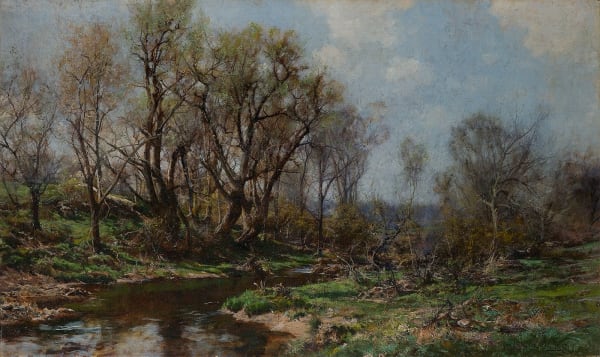Hugh Bolton Jones
Hugh Bolton Jones (October 20, 1848 – September 24, 1927) was an American landscape painter. He grew up in Baltimore, Maryland, where he received his early training as an artist. While studying in New York he was strongly influenced by Frederic Edwin Church of the Hudson River School. After spending four years in Europe he settled in New York in 1881, where he shared a studio with his brother Francis Coates Jones for the rest of his long life. He was celebrated for his realistic depictions of calm rural scenes of the eastern United States at different times of the year, usually empty of people.
Early Life
Hugh Bolton Jones was born on October 20, 1848, in Baltimore, Maryland. His father, John Bolton Jones, was a prominent lawyer and politician, and his mother, Mary Ann Bolton Jones, was a homemaker. Jones had two brothers, Francis Coates Jones and Edward Bolton Jones.
Jones showed an early interest in art, and he began taking art classes at the Maryland Institute of Art in Baltimore when he was just 12 years old. In 1866, he enrolled at the National Academy of Design in New York City. While at the National Academy, Jones studied with such notable artists as Frederic Edwin Church, Thomas Cole, and Asher B. Durand.
Early Career
After graduating from the National Academy in 1869, Jones traveled to Europe to study the Old Masters. He spent four years in Europe, traveling to France, Italy, Spain, and North Africa. While in Europe, Jones continued to paint, and he exhibited his work in Paris and London.
In 1873, Jones returned to the United States and settled in New York City. He shared a studio with his brother Francis Coates Jones, and the two brothers became known for their realistic depictions of American landscapes. Jones's paintings were praised by critics for their accuracy and their beauty.
Mature Career
In the late 1870s, Jones began to experiment with new painting techniques. He began to use a looser brushstroke and to apply paint more thickly to his canvases. This new style of painting was influenced by the work of the French Impressionists.
In the 1880s, Jones began to focus on painting scenes of the American West. He traveled to the West several times, and he painted a number of well-known paintings of the region, including "The Rocky Mountains" (1882) and "The Grand Canyon of the Colorado" (1883).
In the 1890s, Jones returned to painting scenes of the eastern United States. He continued to paint in a realistic style, but he began to use a more subdued palette. His paintings of this period are characterized by their quiet beauty and their sense of serenity.
Later Life and Death
Jones continued to paint until his death in 1927. He was 78 years old. He is buried in Green-Wood Cemetery in Brooklyn, New York.
Legacy
Hugh Bolton Jones was a major figure in the American landscape tradition. His paintings are characterized by their accuracy, their beauty, and their sense of serenity. Jones's work is included in the collections of many important museums, including the Metropolitan Museum of Art, the Museum of Modern Art, and the Whitney Museum of American Art.
Jones was a member of the National Academy of Design and the American Watercolor Society. He was also a trustee of the Brooklyn Museum.
Jones's work continues to be admired by artists and critics alike. He was a master of the landscape genre, and his paintings are a testament to his love of nature.


